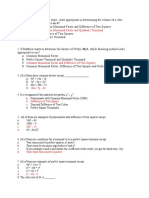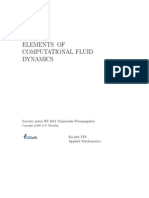Differential Equations Applied To Systems Engineering and Computer Science
Uploaded by
ScribdTranslationsDifferential Equations Applied To Systems Engineering and Computer Science
Uploaded by
ScribdTranslationsSystems and Informatics Engineering
Gelacio Pozo Pino
DIFFERENTIAL
EQUATIONS
APPLIED TO SYSTEMS
AND COMPUTER
ENGINEERING
Jonatan Josias Simon Vargas
INTRODUCTION
Understanding nature and its phenomena requires the help of mathematics, and differential and difference
equations are an essential tool for mathematicians, physicists, engineers and other technicians and
scientists, since it often happens that the physical laws in which they are found normally natural
phenomena expressed in the form of differential equations, so that they represent in themselves a
quantitative expression of these laws: for example, the laws of conservation of mass and thermal energy,
the laws of mechanics, etc. They are expressed in the form of differential equations. The equations of
motion of bodies (Newton's second law) are a second-order differential equation, as is the equation that
describes oscillating systems, wave propagation, heat transfer, diffusion and movement of subatomic
particles, etc
Differential equations are extremely important for engineers, especially in their applications, mainly
because they can reduce research on many scientific and technical problems to solve such equations. The
calculations necessary to build engines or radio technology equipment, the calculation of projectile
trajectories, the study of aircraft stability or chemical reaction processes in flight depend on the solution of
the differential equations that must be solved. . Today's rapidly evolving technologies such as modeling
and simulation.
DEFINITIONS
Differential equations
Differential equations are considered mathematical equations that connect functions and their derivatives.
Therefore, in applied mathematics, the function actually represents the physical quantity, the derivative
represents the rate of change, and the equation defines the relationship between them. Because these
relationships are so common, differential equations play a fundamental role in many disciplines.
By investigating and analyzing differential equations from different angles, most of which refer to the set
of solution functions that satisfy the equation. Only the simplest differential equations can be solved by
explicit formulas, but certain properties of the solutions of certain differential equations can be established
without finding their exact form.
Systems and IT
A system is understood as an ordered collection of interrelated components with a related structure, a
specific structure, composition and environment, whether a material element or a conceptual element.
This term is applied to various fields of knowledge, such as physics, biology and information technology
or computers. The world can be studied from a system perspective, where all objects are part of a certain
system, from atomic particles to the cerebral cortex, representative democracy or integers. In this way, a
system is nothing more than a real part that can be studied independently of the rest, and its various
components are interrelated.
As a discipline, computer science or computer science has conducted scientific research on the physical
and theoretical limits of computers, their processing, network architecture, information storage, and even
artificial intelligence. On the other hand, computer engineering applies computer science theories to
methods, technologies, processes, development and applications. Therefore, computing is a vital science
today because it has many applications that can facilitate data processing, storage and analysis, and
communication.
Differential Equations in Systems Engineering and Informatics
In this monograph, applications of differential equations will be seen on some topics that are covered in
the systems engineering and computer science degree, from Electrical Circuits, programming, Big Data,
AI,... etc.
Differential Equations Applied to Electrical Circuits.
In this chapter we will see the analytical solutions of DC circuits applying differential equations. This
method stands out among the various mathematical methods used to solve the circuit, having exemplary
elegance and the ability to provide complete responsiveness, that is, from the moment the circuit is
energized until it is interrupted. Completely resolve all phenomena occurring in the circuit.
Example:
Transient and permanent states in passive circuits Inductive series circuit The general form of the RL
circuit, connected in series under excitation. Continuous voltage; Otherwise, the excitation will not
depend on the position. The initial position of the switch (1 or 2), such as The following circuit:
When the switch is in position 1, the response to the excitation voltage will be current i, which will
produce approximately Resistance and inductance voltage drops, They will be given by the following
equations:
Applying Kirchhoff's second law to the circuit (on in position 1), we obtain the relationship between the
instantaneous value of the voltage and time.
Differential Equations Applied to Neural Networks
Differential equations are also applied to neural network studies, an example is the ODE-Solver system
that was presented at the NeurIPS congress (One of the most important congresses on Artificial
Intelligence)
The name of the system is ODE-Solver, where ODE is short for "ordinary differential equation": then the
ordinary differential equation solver. These are mathematical models of interrelated behaviors of different
sizes.
This ODE-Solve system works as follows, instead of specifying a discrete sequence of hidden layers, we
parameterize the derivation of the hidden state using a neural network. The output of the network is
calculated using a black-box differential equation solver. These continuous depth models have constant
storage costs, adapt their evaluation strategy to each input, and can explicitly trade numerical precision for
speed. We demonstrate these properties in continuous residual depth networks and continuous time-
varying latent models. We also create continuous normalization streams, a generative model that can be
trained with maximum likelihood without partitioning or sorting data dimensions. For training, we show
how an ODE solver can be reduced without access to its internal processes. This allows for
comprehensive AOD training on larger models.
Left: A residual network defines a discrete sequence of finite transformations. Right: An ODE network defines a vector field,
which continuously transforms the state. Both: Circles represent assessment locations.
Latent ODE Model Calculation Chart
Differential Equations and Python
Although we probably already know that they are differential equations, what is Python? Python is a
platform-independent, object-oriented scripting language ready to run any type of program, from
Windows applications to web servers and even web pages. It is an interpreted language, which means it
can be run without compiling the source code, it has advantages such as development speed and the
disadvantage of slower speed. It is one of the few languages that has an extensive library on Differential
Equations, Neural Networks and Artificial Intelligence.
Although some ordinary differential equation problems can be solved analytically, problems that cannot
be solved analytically are more common. Therefore, in these cases, we must resort to numerical methods.
Here, computer capabilities, especially scientific Python packages (such as NumPy, Matplotlib, SymPy,
and SciPy) become extremely useful. Let's see how to use computational power to solve differential
equations.
SymPy provides us with a universal ordinary differential equation solver sympy.dsolve, which can find
analytical solutions for many basic ODEs. Although sym py.dsolve can be used to solve many simple
ODEs symbolically, as we will see below, we must remember that most ODEs cannot be solved
analytically.
For example, if we wanted to solve the following differential equation:
We must carry out the following procedure:
General Solution of the Differential Equation
Here we replace the values of the initial condition.
Result
We solve for the value of the Integration constant.
Result for the particular exercise.
In conclusion, differential equations served a lot to achieve the significant advance that we currently have
in technology, since the main technologies that were developed in this last century are related to it, from
Artificial Intelligence, Machine Learning, Electric Circuits, Models. computing, Computer virus tracking,
Simulations, Data analysis,... etc.















































































































